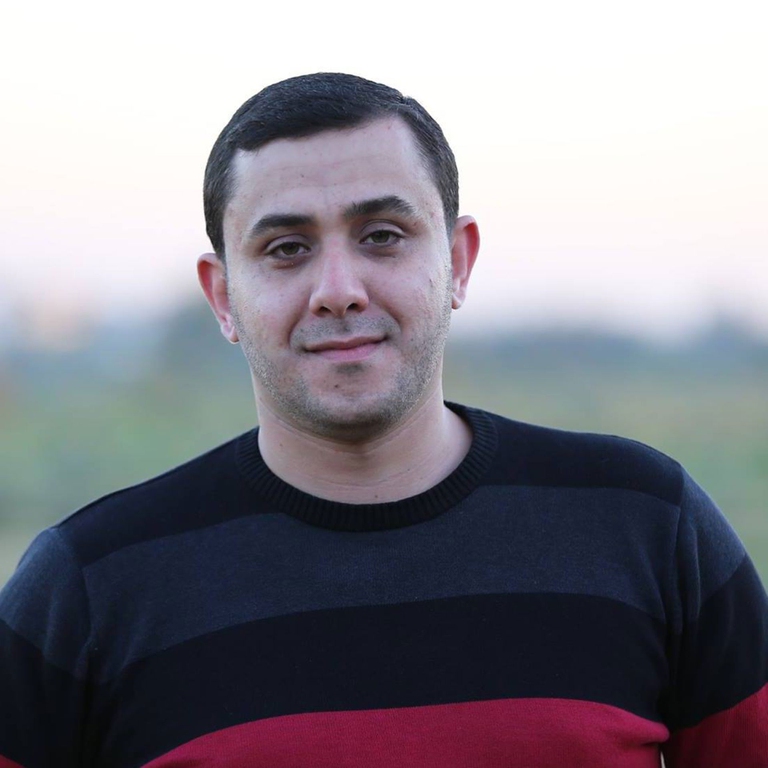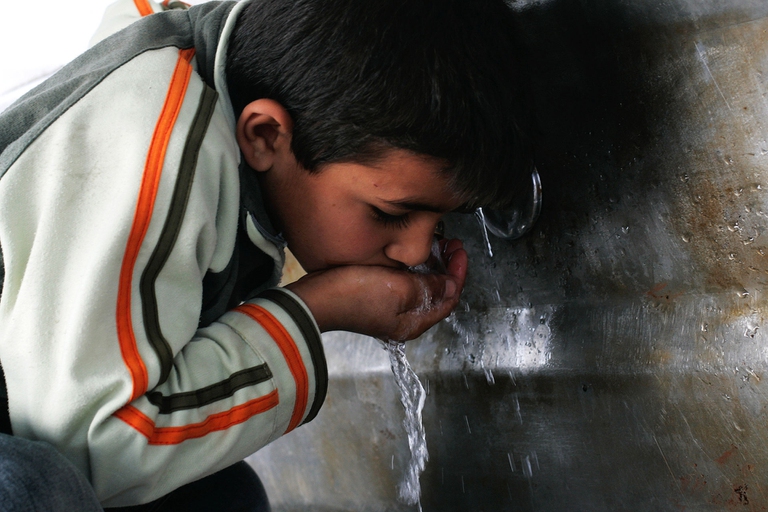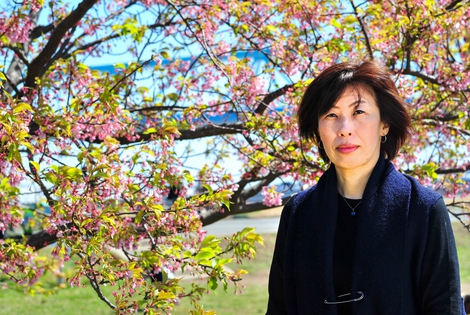
Three people putting the protection of the planet before themselves. Three powerful stories from Latin America, the deadliest region for environmental activists.
Over 90% of Gaza’s groundwater isn’t safe to drink. Mosab al-Hindi is fighting against huge odds to preserve water resources there.
curated by Christian Elia
“Over 90 per cent of the water in the Gaza aquifer isn’t safe to drink without being treated, so most people depend on private sellers and desalination plants for potable water. Water has become a privilege and no longer a right. Knowing this is enough to make you want to do something about it. We have to act, and act now. Time has already run out”.
Mosab al-Hindi is a man of few words. Young, but blessed with the wisdom that characterises those born in Gaza, a place that makes people grow up fast. Mosab works for the MA’AN development centre, an independent Palestinian organisation founded in January 1989, where he specialises in research and development as well as education. The organisation’s headquarters are in Ramallah, with an office in Gaza too. MA’AN works to support the to creation of independent initiatives that help create the human resources needed for sustainable development. Self-sufficiency and empowerment are key values. This approach also seeks to emancipate Palestinians from dependence on international cooperation. Nowadays, following the rise of the Trump administration in the US and budget cuts across many international organisations, this vision has gone from simply being desirable to necessary.
Mosab’s words might seem alarmist or exaggerated to those who don’t know what is happening in Gaza. Five years ago, UN researchers raised the alarm by revealing that by 2020, the Gaza Strip could no longer meet the minimum requirements in terms of access to resources that make an area habitable for humans. With 2020 coming to a close, very little has changed. In fact, the Covid-19 crisis has aggravated the already dire situation.
The Gaza Strip extends for 360 square kilometres and is inhabited by almost two million people, with a population density among the highest on the planet. 56 per cent of its citizens are children, almost 80 per cent are families living below the poverty line and 74 per cent are refugees, who survive thanks to UNRWA aid. “In Gaza, people are going through the garbage,” Philippe Lazzarini, United Nations Relief and Works Agency (UNRWA) chief, declared. “More people are fighting to provide one or two meals a day to their families”.
This is the context which Mosab works in every day. “I’m in charge of the development centre’s programme. I manage a number of Wash and Shelter projects, which aim to support vulnerable families and improve their access to basic needs, especially water. Access to drinking water is a critical issue here”, Mosab explains. “In Gaza, the only natural water source is the coastal aquifer, which is fed solely by rainwater. Currently, the population extracts almost three times as much as is replenishes annually. Excessive pumping has led to a significant decrease in the aquifer’s level, which in turn has led to the intrusion of saltwater from the Mediterranean Sea, which contaminates the groundwater. The lack of proper wastewater treatment plants and consequent infiltration from wastewater collection basins has further aggravated the aquifer’s rapid deterioration. This is a serious public health risk“.
Even Israel, which has kept the Gaza Strip sealed off since 2007, admits to the problem. On the 3rd June, a group of researchers from Tel Aviv and Ben Gurion universities in Israel presented Health Risks Assessment for the Israeli Population following the Sanitary Crisis in Gaza. The report, commissioned by environmental organisation EcoPeace Middle East, warns that “the deterioration of water, electrical and sewage infrastructure in the Gaza Strip constitutes a substantial danger to groundwater and seawater, beaches and desalination plants in Israel”.
“The weakness of water networks and constant interruption to the supply of electricity have a negative effect on the availability of water for domestic use, as most households depend on small pumps to get water into their houses,” Mosab explains. “The situation in refugee camps is even worse because of the high population density, which puts pressure on domestic water networks and water availability. Furthermore, high levels vulnerability negatively influence families’ ability to ensure sufficient amounts of drinking water”.
A Rand Corporation study, published by Israeli newspaper Ha’aretz in October 2018, points to diseases caused by water pollution as one of the main causes of child mortality in the Gaza Strip: these are behind over a quarter of diseases in Gaza, and up to four years ago over 12 per cent of child deaths were linked to gastrointestinal disorders caused by contaminated water. In 2016, five-year-old Mohammad al-Sayis ingested wastewater-contaminated seawater, which contained faecal bacteria that led to a fatal brain infection. Mohammad’s death, reported in an al-Jazeera special on water conditions in Gaza, was the first confirmed sewage-related death in the Strip.
“Mohammed’s story shocked those who don’t live in Gaza. But here, there are cases like Mohammed’s every single day,” Mosab recounts. Cooperative interventions, be they humanitarian or for development purposes, try to ensure a minimum level of water quantity and quality. Often it comes down to implementing technical solutions for what are really political problems. “Israel prevents many replacement and key spare parts for water infrastructure from entering Gaza, categorising them as being for ‘double use’: if Israeli authorities claim that a device can be modified or employed for military purposes, they block it. Furthermore, Israel has water catchment basins in border regions that gather rainwater that flows into Gaza from Hebron. This has a negative effect on the amount of water that returns to the aquifer”.
Every day, Mosab wakes up and starts another day facing an uphill battle against an immense problem. But he remains determined to fight and voice his indignation. “We need to guarantee interventions at both the community and systemic level: seawater desalination plants, improved rainwater catchment systems, improved water storage and constant outreach campaigns to raise awareness among people about rationing water”.
For those who can afford it, how much does water in Gaza cost? How much does the average family spend on this vital resource? “It depends on many factors, including the hours of electricity available in a day, where they’re located within the Strip. In Gaza, farmers spend so much more on water if we also take into account the electricity crises that negatively affect their income and cost them serious losses in many seasons. It isn’t easy to explain to people that everyone plays a part. I go to homes, schools, camps, speak to parents, students, farmers… But no matter how committed we are, if urgent interventions don’t take place the situation will only get worse“.
In Gaza, when you ask for water, the response will often be: “It’s like drinking a glass of seawater”. Even the sea, which is the only corridor to escape the besieged Gaza Strip, is becoming the enemy by contaminating groundwater.
Water Defenders is a Water Grabbing Observatory project celebrating the tenth anniversary of the recognition of the human right to water through a series of interviews that tell the stories of grassroots battles being fought for water all over the world. A multi-faceted struggle against resource exploitation and large as well as small projects that impact communities and natural environments. Ordinary yet extraordinary men and women across the world are defending this fundamental human right. Starting from World Water Day, 22 March, LifeGate regularly publishes features by the Water Grabbing Observatory, each centred on a person fighting to protect the most precious resource we have. And claim their right to water.
Siamo anche su WhatsApp. Segui il canale ufficiale LifeGate per restare aggiornata, aggiornato sulle ultime notizie e sulle nostre attività.
![]()
Quest'opera è distribuita con Licenza Creative Commons Attribuzione - Non commerciale - Non opere derivate 4.0 Internazionale.
Three people putting the protection of the planet before themselves. Three powerful stories from Latin America, the deadliest region for environmental activists.
Influential scientist, activist and author Vandana Shiva fights to protect biological and cultural diversity, and against GMOs.
Kimiko Hirata has blocked 13 new coal plants in Japan, but she hasn’t done it alone. The 2021 Goldman Prize winner tells us about her movement.
The Goldman Environmental Prize, the “green Nobel Prize”, is awarded annually to extraordinary activists fighting for the well-being of the planet.
We talk to Shaama Sandooyea, activist and marine biologist from Mauritius onboard Greenpeace’s Arctic Sunrise ship in the heart of the Indian Ocean.
Arrested for supporting farmers. The alarming detention of Disha Ravi, a 22-year-old Indian activist at the fore of the Fridays for Future movement.
Water defender Eugene Simonov’s mission is to protect rivers and their biodiversity along the borders of Russia, China and Mongolia.
Chibeze Ezekiel, winner of the 2020 Goldman Environmental Prize for Africa, is fighting to guide new generations towards a renewable future.
Leydy Pech, winner of the 2020 Goldman Environmental Prize for North America, is the beekeeper who defended Mexican Maya land against the agro-industry.










